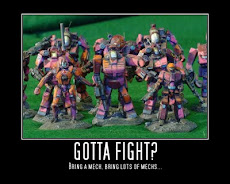This piece is a follow on to my previous entry "Crunching the Numbers." I've been delaying posting this piece for a whole load of reasons. Some are around doubt, and some are due to the effort it has taken me to calculate and then interpret my results.
And then today I had my eureka moment.
After the thought experiments I wrote, I had a fair idea of what a weapon was capable of doing, and the one big things that came out of this was range. If you are out of range, it doesn't matter how good the weapon is, as it can't hit the target.
Thank god for spreadsheets is all I can say. The new algorithm that I came up with today is as follows:
(R/9)*D/(W+H+A) = CV
Range divided by 9 times Damage, all divided by Weight plus Heat plus Ammo equals a weapons combat value.
What we get is a range of results as follows:
Machine gun: CV = 4
Autocannon 2: CV = 7
Autocannon 5: CV = 10
Autocannon 10: CV = 10/10
Autocannon 20: CV = 9/9/8/8
Ultra autocannon 5: CV = 10/9 (13/12 double shot)
LB10X autocannon: CV = 14
Gauss Rifle: CV = 22/20
Small laser: CV = 7
Medium laser: CV = 13
Large laser: CV = 10
PPC: CV = 12
ER large laser: CV = 10
ER PPC: CV = 15
Small pulse laser: CV = 3
Medium pulse laser: CV = 5
Large pulse laser: CV = 6
Flamer: CV = 2
SRM 2: CV = 8
SRM 4: CV = 8/7
SRM 6: CV = 10/9/8
Streak 2: CV = 9
LRM 5: CV = 14
LRM 10: CV = 16/15
LRM 15: CV = 18/17/16
LRM 20: CV = 18/17/16/15
The numbers with slashes indicate how the combat value changes as you increase the ammunition from one ton, to two tons and so on. The reason for doing an extended calculation on some, but not all the weapons that carry ammunition, is that some weapons come up rather short, and I wanted to see if carrying more ammunition affect the combat value adversely.
In particular the autocannon 20 with five shots is a bit of liability, and my gut feeling was that four LRM5 were as good as having an LRM20, which they nearly are.
Summary
According to these calculations the gauss rifle rocks, followed by the LB-10X, which pretty much sums up my players feelings about carrying projectile weapons. The UAC5 is good when double firing, but otherwise it appears that it doesn't offer much over a standard AC10.
Unsurprisingly, in the energy weapon category, the medium laser still looks good. But not as good as an ER PPC, and it only has a marginal lead over the PPC, which has a longer range to compensate for the one point difference.
With the missile launchers, I was surprised to see that the LRM15 appears to be the best LRM launcher to have from this algorithm. While the Streak2 is notionally the best SRM launcher, but there is not much in it really.
Your thoughts, considerations on what is implied, as always very welcome.








.png)





